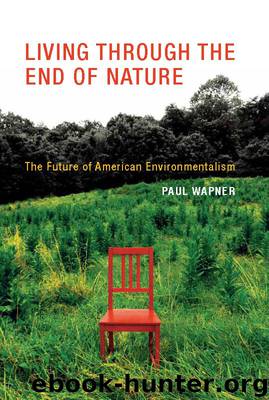Living Through the End of Nature by Paul Wapner

Author:Paul Wapner [Wapner, Paul Kevin]
Language: eng
Format: epub
ISBN: 9780262265706
Publisher: The MIT Press
Published: 2010-03-16T16:00:00+00:00
‘‘Water’s Freedom,’’ Niagara Falls, New York
6 The Nature of Wilderness
In human culture is the preservation of wildness.
—Wendell Berry
Wilderness has long been dear to American environmentalism, and its preservation remains one of the oldest aims of the movement. Since the nineteenth century, when philosophers Emerson and Thoreau and wildlife enthusiast Muir lamented the disappearance of wilderness under the foot of industrialization, to the movement’s more modern expression in the twentieth century with the emergence of organizations such as the Sierra Club, the Nature Conservancy, Wilderness Society, and Wildlands Project, the American environmental movement has been committed to protecting wildlife and wildlands from excessive human encroachment. The tradition continues today. Each year, environmentalists in the United States (and around the world) work to safeguard established wilderness areas in the form of parks, refuges, bioreserves, and so forth, and seek protection for so-called wild places that have yet to enjoy official protected status.
The empirical end of nature and social constructivist ecocriticism question these efforts as well as the long tradition of wilderness preservation. They raise significant issues about the meaning of wilderness itself. When most of us think about wilderness, we have in mind a dark forest, expansive mountain range, or deep canyon far from people, where plants and animals can live out their lives undisturbed by human beings. As I described in the last chapter, there are no such places anymore. The expansion of agriculture and human settlements, to say nothing of anthropogenic climate change, have, on the one hand, pushed wilderness to the furthest reaches of the planet, and on the other, inflected all ecosystems with a human signature such that it is impossible to now distinguish where humanity ends and nature begins, or more relevantly, where genuine wildness reigns. What should environmentalism do in such a situation? Should it abandon the effort to protect wilderness, since it is doubtful if ‘‘real’’ wilderness even exists any longer?
Ecocriticism adds to this challenge by suggesting that wilderness is not some universally understood condition that a body of land or water inherently possesses but rather a socially constructed idea reflecting certain sociohistorical understandings. Throughout history, few people would have defined a dark forest or deep canyon as wilderness simply because it may be devoid of human beings, and the same is the case today. Indeed, what many of us imagine as wilderness merely embodies the ‘‘received wilderness idea’’—a concept that has been cultivated over the years by given societies and is meaningful to only a portion of the world’s people.1 Understanding wilderness in this way forces us to ask about environmentalists’ wilderness protection efforts. What does wilderness preservation mean in light of constructivist thought? Does it matter that wilderness protection is not really about preserving a piece of land in its ‘‘given’’ state but instead a matter of inscribing a particular vision onto a circumscribed area?
This chapter aims to answer such questions by exploring the kind of middle path I began describing in the last chapter. Such an approach is one in which
Download
This site does not store any files on its server. We only index and link to content provided by other sites. Please contact the content providers to delete copyright contents if any and email us, we'll remove relevant links or contents immediately.
The Secret History by Donna Tartt(18843)
The Social Justice Warrior Handbook by Lisa De Pasquale(12141)
Thirteen Reasons Why by Jay Asher(8792)
This Is How You Lose Her by Junot Diaz(6792)
Weapons of Math Destruction by Cathy O'Neil(6142)
Zero to One by Peter Thiel(5685)
Beartown by Fredrik Backman(5594)
The Myth of the Strong Leader by Archie Brown(5424)
The Fire Next Time by James Baldwin(5248)
How Democracies Die by Steven Levitsky & Daniel Ziblatt(5127)
Promise Me, Dad by Joe Biden(5087)
Stone's Rules by Roger Stone(5026)
A Higher Loyalty: Truth, Lies, and Leadership by James Comey(4842)
100 Deadly Skills by Clint Emerson(4840)
Rise and Kill First by Ronen Bergman(4701)
Secrecy World by Jake Bernstein(4643)
The David Icke Guide to the Global Conspiracy (and how to end it) by David Icke(4624)
The Farm by Tom Rob Smith(4434)
The Doomsday Machine by Daniel Ellsberg(4415)
